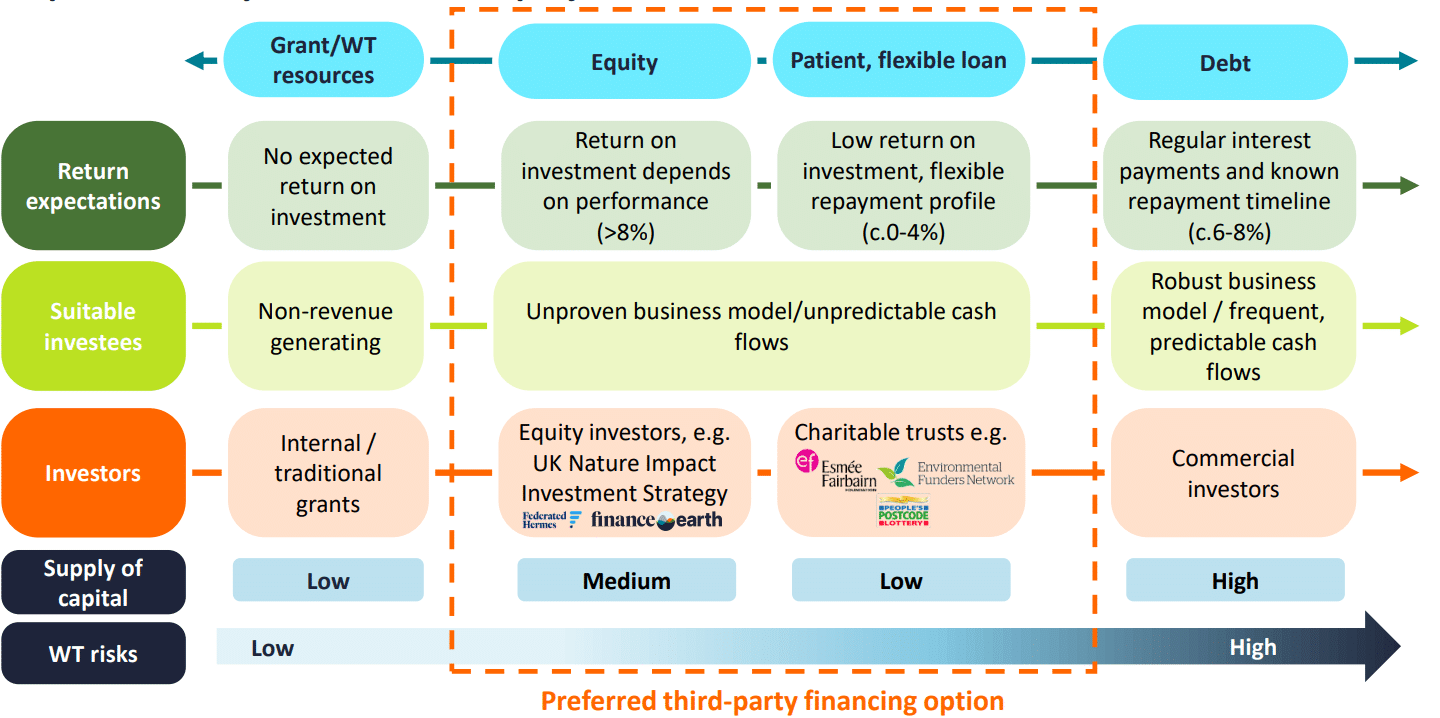Project Overview
A group of Wildlife Trusts and Finance Earth have created an investment model to deliver Biodiversity Net Gain (BNG) units with the use of upfront private finance, accelerating the pipeline of habitat creation. The partnership includes four Wildlife Trusts – Berks Bucks and Oxon, Warwickshire, Cheshire and Surrey – that will create and restore habitats across three pilot sites. By using private investment to create the habitats in advance of BNG sales, the Wildlife Trusts will have a higher volume of ‘post-enhancement’ units that will support the financial viability of the project. This approach can also remove the time delay between nature loss from development and off-site habitat creation.
The project sought repayable finance for the acquisition of one of its pilot sites, but did not complete the sale due to the vendor’s decision to sell to another party. However, Heads of Terms for a patient loan were secured.
Acknowledgements
With many thanks for their time and insight on this case study:
Prue Addison, Conservation Strategy Director, Berkshire, Buckinghamshire and Oxfordshire Wildlife Trust

Charlotte Harris, Chief Executive Officer, Cheshire Wildlife Trust
Martin Varley, Director Nature Recovery, Cheshire Wildlife Trust
Alicia Gibson, Senior Associate Director, Finance Earth
Allan Benhamou, Associate, Finance Earth

Date published: 23/06/2023
Defining the investment ask
The model was designed to attract upfront investment to cover land acquisition (if required) and early restoration and maintenance costs to enable the project to sell biodiversity units over time.
Equity investment or a patient, flexible loan were identified as the preferred forms of finance. This was due to the uncertainty of annual biodiversity unit demand, unpredictability of BNG cash flows and long-term project timeframe. The financing options considered are demonstrated in the following diagram:

Site specific investment asks
The financing needed across each project is expected to vary depending on project-specific characteristics. In some cases, repayable finance may not be needed where biodiversity units can be sold in advance of restoration or where upfront costs are low.
For example, in the case of the three pilot sites:
- Oxfordshire site: there is no requirement for third-party finance as the project adopts a rewilding approach, requiring limited upfront capital expenditures. The sales of biodiversity units in advance of delivery are expected to cover costs before additional units are sold.
- Warwickshire site: £1.6m of upfront financing would be required to cover habitat creation costs with returns generated as biodiversity units are sold over a 10 year+ period. Financing for this site is dependent on securing a lease agreement with the landowner.
- Cheshire site: £1.15m of upfront financing would have been required to cover land acquisition and restoration costs, before grants and BNG unit sales could recoup these costs. There was an opportunity to fund the site through securing an unsecured loan from a patient loan provider, aiming to achieve a minimal return, with a payback period of five to seven years. Cheshire Wildlife Trust (CWT) decided that debt was a more suitable option that equity, given that it had more experience with debt-based transactions and was not inclined to set up a separate legal entity to issue equity.
The project team identified the need for financing to be adapted to the features of the habitat banking model to minimize risks. Key investment considerations are included below:
| Habitat banking model features | Investment considerations |
| Upfront cost and funding gap |
|
| High level of market uncertainty over demand and unit sale profile |
|
| 30-year habitat maintenance liability |
|
| Volatile income streams |
|
Approaching the investor
CWT worked with the Wildlife Trusts’ Philanthropic Loans team to approach potential investors. This led to initial conversations with a few individuals, and the project team prepared a further 1-2 page expression of interest document on the business case of the model. One of the interested investors including a local high-net-worth individual who runs a philanthropic foundation and was drawn to the project in part due to their proximity to the site.
At this stage, Martin Varley, Head of Nature Recovery of the CWT, says that demonstrating the ‘nature-based return’ of the project was key. Further conversations with this investor focused on the need for nature recovery within the local area, the potential environmental gains (such as species that would be supported by the habitat), and the project’s community connections. The innovation of the model also appealed to the investor, who was interested in investing in the new BNG market.
Negotiating terms
In total, it took three months of negotiations to agree the Heads of Terms for the loan. However, this was at an early stage of The Wildlife Trusts’ philanthropic lender programme. As the scheme has developed, lending can be agreed much more quickly. At this stage, the project team also provided the full business case to the investor and organised several meetings and site visits.
Varley comments that the investor was happy to accept a 0-2% return. However, they did not want to tie their funds up for the lengthy periods of time associated with BNG. The project team originally aimed for a repayment period of 10 years, but after negotiations it agreed to a five to seven year period in total, with repayments triggered by BNG sales to amortise the loan over time.
CWT decided to set up a local community steering group for the pilot site, to include the investor and other interested community members. This group would be updated on the project’s progress, provide suggestions to the CWT team and input into certain decisions.
After three months, the investor and CWT were ready to form a Memorandum of Understanding before engaging with lawyers. However, at this stage, the landowner of the site decided to sell the site to a different buyer. The investment therefore did not proceed.
Lessons learned
From working with the investor on this project, the project team says it is important to:
- Have a clear idea as to how much money you want and what you’re going to use it for. Varley comments that the team had a rough figure for the land acquisition to begin with, but exploring the hybrid BNG sales approach through the financial model (see Milestone 5) made a big difference on the number with which they first approached investors.
- Foster a good relationship with your investor, make them feel part of what you’re doing by emphasising the environmental benefits of the project and being open to ideas they have about the project and its execution.
- Be transparent and communicative about how the project is progressing and challenges or risks that could stop the project. Investors do not like to be kept in the dark, and when the landowner decided to sell the site to another buyer, Varley says that the investor was understanding and not upset as to the loss of the investment opportunity. Instead, CWT has retained the relationship amicably and feels it can approach the same investor with other opportunities relating to the model in the future.